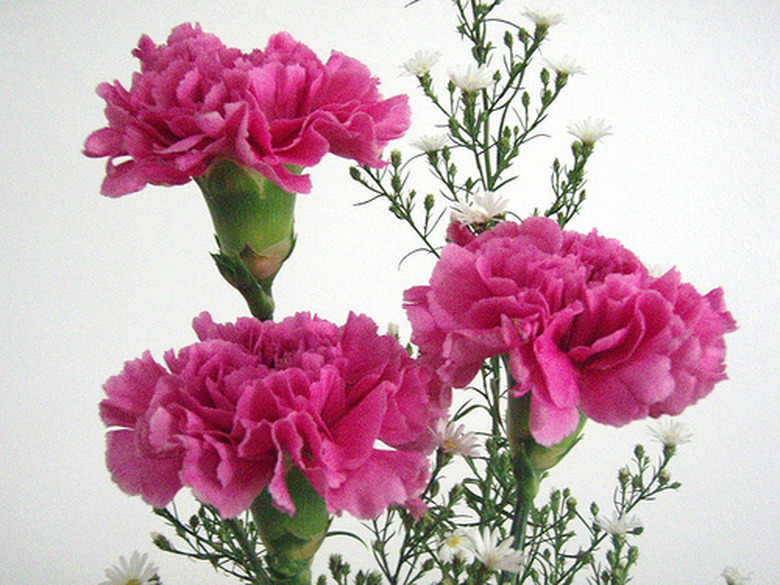How To Take Care Of Carnations
Things Needed
- Garden tiller
- Organic compost
- Organic mulch
- Liquid fertilizer
Tip
Seeds planted directly into the garden will not flower the first year. For first-year flowers, start the seeds indoors six to eight weeks before the first frost of the year, and transfer the seedlings to the garden bed. Try using organic bark mulch, grass clippings, straw or shredded leaves to mulch carnations. Pine needles also are a good choice because carnation plants prefer a slightly acidic soil and the needles add acidity as they decompose.
Warning
If you don't pinch off flower buds on the side of carnation stems, you'll get multiflowered carnations, also known as sprays. They are equally beautiful, but don't make good cut flowers. Don't pinch if you are growing carnation flowers simply as garden plants and don't plan on cutting the flowers for display.
Carnations are flowering plants native to Europe and Asia. They are one of the most popular commercially produced cut flowers, and are prized for their attractive ruffled flowers. They are a traditional gift of love and friendship on Valentine's Day in America. Carnation flowers bloom in late spring through midfall, and each bloom lasts up to two weeks. Colors of white, pink, purple, red, orange and yellow are common. Carnations are typically grown as annuals, although many species are actually perennials and can be grown for many years with the proper care.
Step 1
Plant carnation seeds or seedlings 10 to 12 inches apart in a prepared garden bed in late spring or early summer. Choose a planting site that receives full sun to partial shade, and that has well-drained, fertile soil. Use a garden tiller to mix in a 2- to 4-inch layer of organic compost prior to planting for the best results.
- Carnations are flowering plants native to Europe and Asia.
- Carnations are typically grown as annuals, although many species are actually perennials and can be grown for many years with the proper care.
Step 2
Water carnations thoroughly after planting to settle the soil, and then water once per week during the spring and summer months any time the rainfall is less than 1 inch. Do not over-water because this will cause the foliage to turn yellow.
Step 3
Apply a 1- to 2-inch layer of organic compost to the soil surrounding carnations each spring. Follow with a 2-inch layer of organic mulch. But keep a 2- to 3-inch perimeter around the stems clear. Carnation plants require good air circulation around the stems and can suffer from disease if mulched too heavily.
Step 4
Fertilize carnations once every six weeks during the spring and summer using a 20-10-20 NPK liquid fertilizer according to the manufacturer's directions. Water thoroughly after application to ensure proper distribution of the nutrients.
- Water carnations thoroughly after planting to settle the soil, and then water once per week during the spring and summer months any time the rainfall is less than 1 inch.
Step 5
Remove spent flower blooms on tall varieties as soon as possible to promote new blooms and extend flowering time. Cut back mounding varieties to within 6 inches of the soil line after blooming to encourage a second flowering. Pinch off any flower buds that grow on the sides of the stems if you want cut flowers, and leave only one bud at the top of the stem.
Step 6
Cover annual carnations with a light organic mulch in the fall to protect them from winter temperatures. In many cases, they will emerge again the following spring. You also can bring plants or cuttings indoors during the winter, place them in a cool, sunny window, and then replant outdoors in the spring.
References
- Carnation Production and Consumer Care
- National Gardening Association: Dianthus
- Annuals for Every Purpose: Choose the Right Plants for Your Conditions, Your Garden, and Your Taste; Larry Hodgson; 2002
